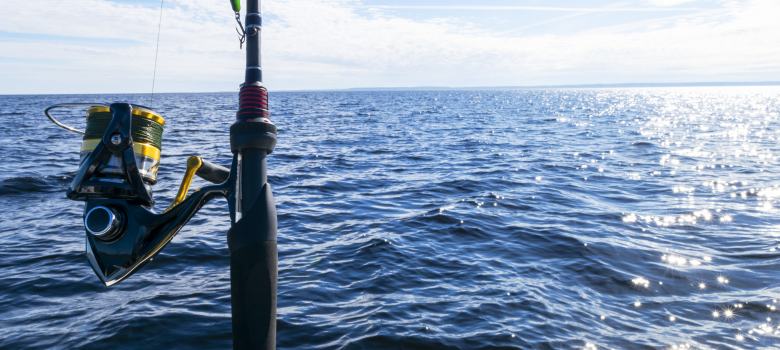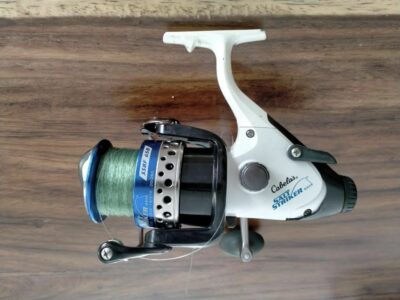If you buy via a link on this page, we may receive a commission, at no extra cost to you.Learn more
Saltwater reels are generally more expensive than freshwater reels. It is because they are built for larger, more powerful fish. Saltwater reels are sealed to withstand the effects of saltwater and to extend their longevity.

The reel needs to be kept clean and lubricated. If you fail to maintain the reel, it will eventually cease functioning. Sadly, reel malfunction usually occurs when you are fishing. This outcome is preventable if your reel is cleaned well.
How can I safely clean my reel after saltwater fishing?
There are basic procedures to follow when cleaning your reel. Read on for best practices for cleaning and caring for your saltwater reel. Firstly, let’s look at what materials are required for maintenance.
What do I need to clean my saltwater reel?
- Spray bottle, fine mist filled with clean water
- Clean rags and paper towels
- Toothpicks and wooden skewers
- Tweezers and Philips screwdriver
- Qtips and cotton wool swabs
- Old toothbrush
- Manufacturers reel oil and grease
What Is The Least Amount of Care I Need To Give My Saltwater Reel?
Whether fishing inshore or offshore, on the sea or ocean, your reel will be exposed to the corrosive effects of saltwater. It is imperative, that you clean the reel as soon as you finish fishing. I always keep a spray bottle filled with fresh tap water in my car.
Once the saltwater has been rinsed away, take the reel off the rod. Holding the reel as it fits on the rod, spray the reel with fresh water. Shake off excess water and dry with a clean rag or towel. Sometimes there may be more than just salt on your rod and reel.
Is Fish Blood Going To Damage My Reel?
Saltwater fishing can be fast and furious. Hauling in large saltwater fish can expose the reel to blood even if you intend to release the fish. The moisture and salt from the blood will cause corrosion. Blood needs to be removed before it drys.
Keep some rags in your pocket. If it’s impractical to bring your spray bottle, you should at least have drinking water with you. Wet the rag with water and clean off the reel. Stubborn blood can be removed with an old toothbrush. Remove any blood before it drys.
Is Sand Harmful To My Saltwater Reel?
Shore fishing can be an inexpensive and fun activity. The downside is…there can be a lot of sand. Never set your reel down on the sand. Sand can work its way into the working parts of the reel and cause damage. If your reel does end up in the sand- the sooner it is cleaned the better.
First, keeping your reel upright, gently tap the reel to get rid of most of the sand. Never turn your reel upside down as the sand will go deeper into the body of the reel. Once most of the sand appears to be gone the reel needs to be rinsed with fresh water. Use the spray bottle and turn the reel whilst spraying. If you only have drinking water then slowly rinse the reel. Dry the reel and continue fishing.
What If I Drop My Reel Into Salt Water?

Accidents happen. As soon as the reel is exposed to saltwater the bearings and other working parts will start to corrode. Dealing with the reel quickly will prevent major damage. If your reel becomes submerged in saltwater whilst out fishing or just before you start to fish, clean off the salt water quickly. Use your spray bottle to rinse off the reel before drying.
Once home, the reel needs to be cleaned properly. Remove the reel from the rod. Now remove the spool and handle. Next, remove the side plate and the side case. Spray everything lightly with fresh water and dry off. Using ONLY manufacturer-approved oil, lightly lubricate the working parts. Use only one drop at each inner part of the reel. Using too much oil will cause damage. Reassemble the reel. It is now ready to safely store.
What’s The Best Way To Clean My Reel?
We have already discussed spraying down your saltwater reel after every trip. After every three trips, I like to give it a better clean.
Disassemble the reel. Check for any dirt, sand, or corrosion.
Gently remove any grit using Qtips, cotton wool swabs, and toothpicks. If something is harder to remove, try using tweezers. Be gentle with the tweezers and do not force anything.
Apply reel oil sparingly if you think it needs it. Reassemble the reel and loosen off the drag. Finally, I like to spray the outside of the reel with Blakemore Real Magic. It is an odorless approved spray. It softens, lubricates, and extends the life of your fishing line. After spraying, dry with paper towels.
Annually, I take my saltwater reel to a professional technician to have it professionally cleaned and inspected. A technician will give your reel a full service. They can tell you if any parts need to be replaced. Having the reel serviced professionally will ensure its longevity.
A Word Of Warning
Some time ago, I watched a “How To” YouTube video about cleaning a saltwater reel. I was shocked. The video stated that after a reel has fallen into saltwater, spray it liberally with WD40. Next, the video said to apply petroleum jelly as a lubricant to the inside of the reel before reassembling it. The “expert” destroyed that reel.
Petroleum jelly is harsh and will eat plastics, rubber, and seals on bearings. WD40 will break down the grease and oil in your reel.
Never use soap or detergents to clean your reel, only fresh water. Do not use a pressure hose or put your reel under pressurized water.
Final Thoughts
Use common sense when cleaning your reel. There are products specifically manufactured to clean saltwater reels. Don’t rely on quick and cheap fixes. You will ensure many more days of fishing when you clean and care for your saltwater reel.




